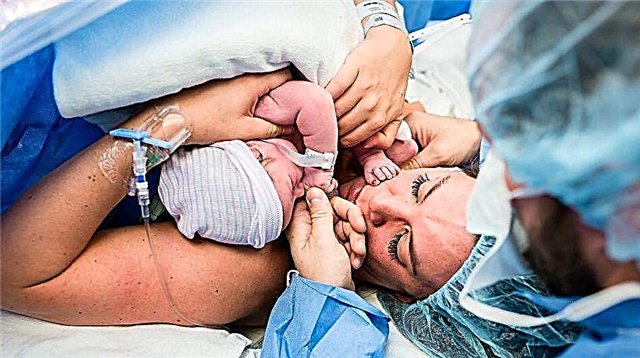Having given birth to a baby, a woman immediately begins to worry about how to breastfeed him, whether she has enough milk, whether it will last for a long time. In this article, you will find answers to the main questions.

1. When to start breastfeeding a newborn?
Inexperienced mothers are often worried if the feeding schedule gets lost. This excitement can negatively affect the development of lactation. Even experts are now abandoning conservative recommendations and leaning towards a more flexible approach, because all babies are individual. According to experts, every mother and child should find the best time to start feeding themselves.
To stimulate suckling, the infant is usually breastfeed immediately after birth. This technique is called "climbing to the breast": the baby seems to crawl over the mother's belly and naturally finds the nipple. Even if a woman underwent a cesarean section, you can still put the baby on her stomach. While the operation continues, the mother and baby will have their first tactile contact. If the woman was injected with an analgesic drug during natural childbirth, and the baby was born slightly sleepy, the doctors will help him to get into the correct position.

It is best to breastfeed the baby for the first time within the first hour after birth. The closeness of mom and baby is necessary to stimulate the synthesis of oxytocin, a hormone that promotes milk production at the very beginning of lactation, reduces stress in women and helps to establish a bond with the baby.
According to the observations of foreign pediatricians, mothers who put babies to their breasts immediately after birth already kiss three-month-old babies more often than those who are not allowed to do it. By the time their babies are 1 year old, they are already forging and maintaining a closer physical bond with their babies and have continued to breastfeed for longer.
2. How to properly attach the baby to the breast?
The newborn should be placed close to the chest. He should be touching the bottom with his chin, but still be able to open his mouth wide enough to wrap his nipple and areola. If the baby touches the base of the nipple with his lower lip, gently lift it from the breast, tilt his head back and attach it again. This is the best nursing position in which the woman does not feel pain.
After feeding is complete, when the baby is “lifted” from the breast, the nipple is elongated, but it should not appear squashed or flattened.

If the mother does everything right, she does not experience discomfort during feeding. The exception is only the beginning of the first few feeds, when the nipples adapt to natural stretch.
3. How do you know if there is enough milk?
You can tell by the baby's weight gain and the contents of the diapers. Don't worry about how long your baby sleeps or how long the intervals between feedings are. Weight gain and diaper content will tell the story. It is also important to note that 5 days after the baby is born, his urine should turn mustard yellow. For 10-14 days, babies regain their weight, which was at birth.

4. How long should each feed last?
On average, a newborn eats from 10 to 40 minutes, but all babies have their own characteristics. Some eat longer, this is also normal, others - much faster if they breastfeed well, and the mother has a lot of milk. However, evening feeds usually last longer than others.

If the baby falls asleep on the chest after a few minutes, you can feed him a little more. There are babies who stay at the breast for a long time and suck it just in order to calm down.
5. How to understand that there is not enough milk, and what to do in this case?
Only 5% of all breastfeeding mothers suffer from a lack of breast milk. The reasons can be disorders in the thyroid gland and hormonal disruption. Sometimes milk is produced little due to insufficient development of breast tissue.
It is important to understand that milk will not run out just like that. It will be produced in such quantities as the baby needs. Therefore, feed the baby as much as he asks for. If you see that there is a problem, start monitoring how the child is gaining weight. Weigh it before and after feedings.
It is also worth checking how the baby takes the breast - perhaps he is doing it wrong. A breastfeeding consultant or pediatrician can also help.
6. Should I breastfeed with only one breast, or then give the other?
Some mothers find it convenient to give their baby one breast in one feeding, and another in the other. Others prefer to offer both during each feed.
Gradually the milk becomes fatter. If the baby eats from one breast and is full, there is no need to offer him the second. It's more important to just keep an eye on the child. If the baby starts to worry and come off, gently remove the breast and offer the other. The child will let you know when he’s finished eating.
7. Can mastitis develop?
Even before mastitis appears, warning signs appear to prevent the disease. If milk is not completely removed from the breast, the ducts may be clogged. In this case, the chest will become heavy, clots will appear in it, and it will feel much warmer to the touch than usual.
To stimulate the elimination of excess milk and establish normal lactation, massage, breastfeed your baby regularly and use a breast pump.
If mastitis has already developed, it can be suspected by red spots on the skin, swollen and very painful breasts.

In severe cases, doctors prescribe antibiotics for women. However, it is still not as difficult to establish lactation and feed a baby as it might seem at first.
8. Up to what age should a baby breastfeed?
According to the recommendation of the World Health Organization (WHO), breastfeeding is recommended for up to 6 months. Appropriate complementary foods can then be introduced by combining them with breastfeeding for up to 2 years or longer.
We recommend publications on the topic of breastfeeding:
- Tips for a nursing mother on organizing hepatitis
- TOP-100 useful tips for a nursing mother
Breastfeeding: video instructions, doctor's advice
Video instruction for mothers on breastfeeding: how to prepare for feeding, what difficulties and problems there may be during breastfeeding, how to properly attach the baby to the breast.




